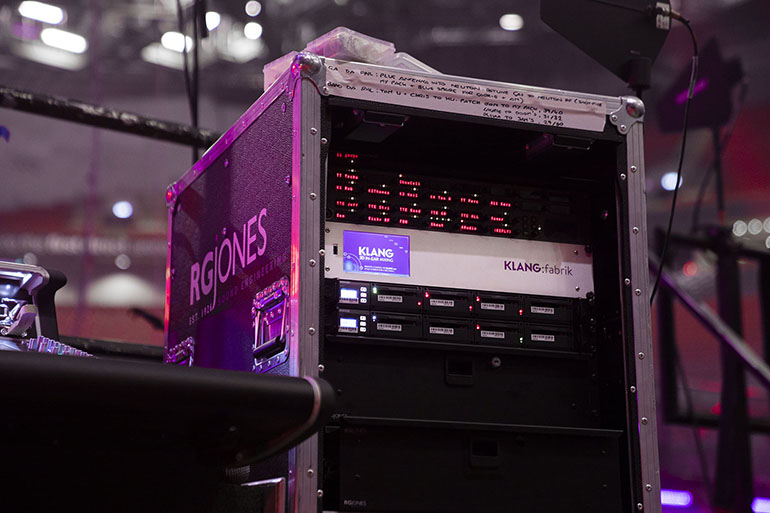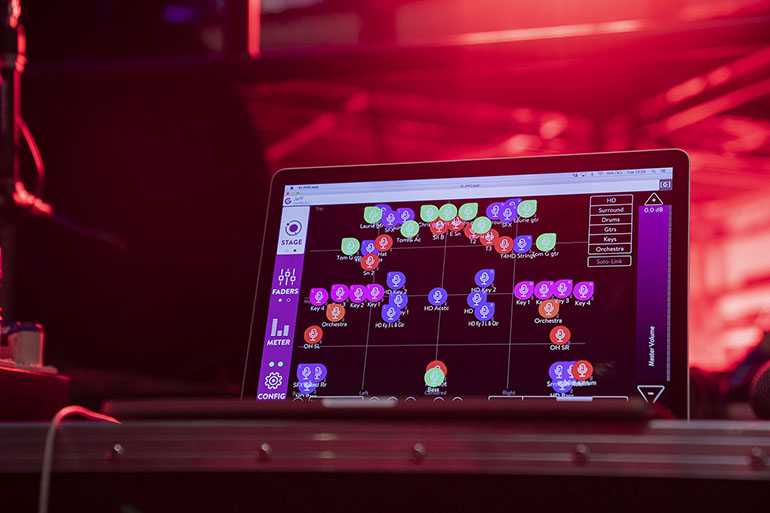Composer Jeff Wayne’s The War of The Worlds, a symphonic, progressive rock retelling of the H.G. Wells classic, was released in 1978 and has since sold millions of copies around the world. The first album to be recorded on 48 tracks, it featured a number of high-profile musicians, including Justin Hayward, Phil Lynott, Julie Covington and David Essex, as well as the voice of legendary Welsh actor Richard Burton.
Over many years, touring productions of The War of the Worlds have received critical acclaim, huge public support and featured notable stars such as Russell Watson, Jason Donovan, Ricky Wilson and Joss Stone playing principal roles. In 2018, Jeff Wayne took to the podium to conduct the latest version during a tour of UK arenas. Eight singers were accompanied by a nine-piece band and 36-strong orchestra to deliver the spectacular show to sold-out audiences across the country.
 Jeff Wayne (right) pictured with the 36-piece orchestra out on his most recent UK tour of The War of the Worlds
Jeff Wayne (right) pictured with the 36-piece orchestra out on his most recent UK tour of The War of the Worlds
On the technical side of the production, for this the 40th anniversary of his iconic masterpiece, Jeff Wayne added a new cast member that, in his own words, added an “extra dimension” to the proceedings. Wayne had been introduced to KLANG—the world’s first truly immersive 3D in-ear mixing technology—by the show’s highly experienced monitor engineer, Becky Pell, who had previously road-tested its qualities on tour with Anastacia.
“I first encountered KLANG when Karrie Keyes of the SoundGirls organization asked me if I’d write an article about psychoacoustics, culminating in discussing KLANG’s technology and how it can help monitor engineers and musicians,” Pell shares. “I was keen to be involved and asked the guys at KLANG if I could take a KLANG:fabrik demo unit out on my tour at the time, Anastacia, to have a play around with and get a feel for it. I was really impressed with the product, both with how it sounded and what it let me create, and also the fact that the space created allowed me to reduce the central element of a mix—i.e. vocal for a singer or click for a drummer—by as much as 6dB. That’s extremely significant in protecting hearing. What I also liked was the fact that it’s a very natural way to listen. KLANG is based on the science of binaural hearing—that is, how we perceive sounds naturally—so it’s far less fatiguing for the brain and ears to listen to than stereo, which is very unnatural. All of these elements led me to think that KLANG would be perfect for Jeff’s mix.”
 The KLANG:fabrik mounted in one of the tour’s audio racks
The KLANG:fabrik mounted in one of the tour’s audio racks
Pell approached Wayne prior to the tour and suggested that he listen to the KLANG demo and compare its 3D properties to stereo. He was immediately onboard with the idea, recognizing that the spatial placement on offer would be of great benefit.
“War of the Worlds is a lot more involved than your average rock and roll tour; Jeff has created this beautifully produced album and my job is to recreate it as faithfully as possible.” Pell continues. “When he’s conducting, he wants to hear it in its entirety. It struck me that it’s a lot of information—168 inputs to get into a stereo mix—and I had the idea that KLANG would help me to create space within all of that… to create depth and width and height and just be able to find separation in the midst of all these elements. It’s proved an absolute winner for him.”
The mix for Wayne represents the full range of his creation, with every aspect clearly audible. The KLANG 3D mix allows for the placement of what might be described as “awareness” elements—effects and surround sound—lower down and behind or to the side, while the more critical elements he is focused on are placed higher and in front. It is clear that he considers KLANG to be a significant step forward.
 Monitor engineer Becky Pell’s KLANG:app user interface
Monitor engineer Becky Pell’s KLANG:app user interface
“When I’m conducting, I’ve got a band on one side and a symphonic string orchestra on the other, and with the KLANG system, the placement of those elements is very much as I’m seeing them, rather than just having a good general mix,” Wayne explains. “The result is that it’s very much more alive—more 3D. I have a better balance in my head, so the sound quality is at a completely different level now than previously. I’d like to stay with the KLANG system whenever I’m performing with in-ear monitoring.”
In practical terms, KLANG is a straightforward addition, as Pell confirms: “It’s very user friendly and takes just a few minutes to get set up. Once it’s patched, I’m basically unaware of it. I have the icon on my computer screen showing where everything is, but it doesn’t actually affect the way I mix. It’s just there, set, creating lots of lovely space!”
The application of KLANG to The War of The Worlds’ production perfectly exemplifies the way in which this leading-edge technology can enable the user to enjoy even the most complex mix in exactly the way they would choose, without any compromise. Jeff Wayne has confirmed his intention to continue with KLANG in-ear monitoring—his experience perhaps confirming Becky Pell’s assertion that returning to stereo would be “like flying business class and then going back to economy...” For Pell, a leading audio professional with an enviable list of credits, KLANG is most certainly the future.
The last word goes to a man whose vision has been seen and heard by millions for four decades: “The system gives me this extra dimension,” Wayne sums. “When I take into account the spatial placement it provides, it’s hard to see why anyone—bands, solo artists with musical accompaniment, or any show—wouldn’t want to enjoy the benefits of KLANG.”